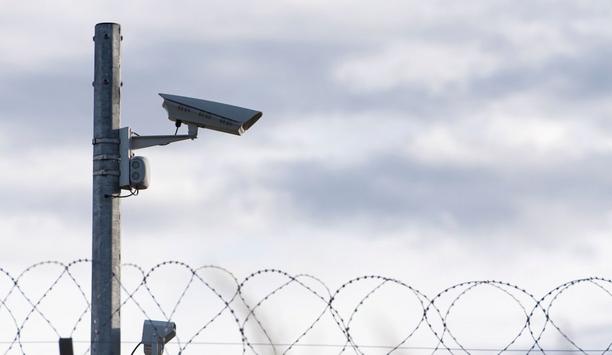The grains that annoy Ulrich Frechenhäuser are tiny. They are almost invisible to the naked eye. The largest samples have an average diameter of just 1.2 millimetres. Typically, though, they are just a fraction of a millimetre thick. STO AG, located in Kriftel near Frankfurt am Main, uses quartz sand to produce adhesives for thermal insulation.
This raw material is small yet powerful: the grains of sand burrow into the tiniest cracks bringing gigantic machines to a creaking halt and constantly grinding down kilometre-long transport pipes until a hole appears. "Every two or three months, something somewhere starts to leak," says Frechenhäuser, who is in charge of the site. He relies on MOBOTIX IP video technology to keep his production processes constantly flowing. And with success, because "we produced 55,000 metric tons this year without any interruptions in our one-shift operations. We’re very proud of that."
STO AG, headquartered in Stühlingen in southern Germany, is one of the world’s leading manufacturers of insulation and coating systems for building facades and interior spaces. The company was founded in 1955, and last year their 4,300 employees helped the company to create revenue of nearly €1 billion. STO AG has 30 subsidiaries worldwide.
Trucks and freight cars run every hour
In an industrial park at the edge of the quiet village of Kriftel, compressed air is used to press and process 270 metric tons of raw material through a broadly distributed pipe system in production buildings every day. At the end of the process, these materials are shipped by rail. The process is prone to interruptions. A new truck with raw materials pulls up to the weighing platform in front of the building about every half hour. The raw material conveyor has to be hooked up very quickly to unload the material. At the other end of the building, the freight cars carry away finished products every hour. Twenty trucks arrive, up to twelve trains await a departure signal every day – a tight time limit for a one-shift operation with just 20 employees. Frechenhäuser puts his dilemma this way: "We focus on every minute."
Video technology in production since 1974
This is where the advantages of MOBOTIX IP technology come into play. "We’ve been using video technology since 1974," Frechenhäuser recalls. The old analogue system has since been replaced with 22 MOBOTIX IP cameras with fixed focal length. The site manager can quickly look at a monitor in his office to see whether a truck will be able to unload on schedule. Time-consuming inspection rounds are a thing of the past. If Frechenhäuser goes into the production halls or stops by the laboratory, then he speaks with his team of 20 members, asks about analysis results, or giving his employees an encouraging clap on the shoulder. Things are down to earth here. Almost everyone has been working in the family business for years.
If there are problems, Frechenhäuser can make a quick initial diagnosis from his office: He can digitally zoom in on an image section with the mouse and keyboard. Thanks to the IP cameras’ high resolution, he can assess any detail reliably. The site manager can see from his office why a production process comes to a standstill, for example. "We can’t apply a classic return-on-investment attitude here. But when I estimate costs and revenues, the ratio of expense to utility is minimal."
"Only a very few manufacturers produce mechanisms and electronics that can hold up for long under such conditions" |
A lot of effort was put into developing the system design. Video security and process automation are closely linked. They run on two physically separated networks, but they are connected via logical interfaces. And that was a challenge at the beginning. Potential-free I/O boxes solved the problem. A time server synchronizes both systems reliably.
On a second-by-second basis, Frechenhäuser is now able to monitor the fill levels of all containers, make target/actual comparisons, and see on the monitor that displays the production flow when and where a process is slowing down. The cameras are displayed in a diagram, and the site manager can view what is happening on a specific machine and watch recorded images in slow motion with a mouse click.
MOBOTIX win comprehensive live test
This saves Frechenhäuser a lot of time: "Previously, I had to inspect minimal disruption. Harmless details often took up an hour of my time." For many years, the analogue cameras used at STO AG were provided by another manufacturer. Yet, the old system eventually reached its limits. Black and white recordings with low resolution were no longer enough for Frechenhäuser. "We simply wanted to have more content directly on the computer screen." IP technology is perfect for this, because it makes high resolutions possible.
The MOBOTIX cameras prevailed over those of the previous supplier in a comprehensive onsite live test under real-world conditions during the tender process. Frechenhäuser was impressed by several advantages of the MOBOTIX technology. First, there was the stability of the systems and then the completely sealed housings with corrosion protection. "We needed very robust cameras that could meet highest requirements without any problems in an industrial environment with a high proportion of dirt in the production process." MOBOTIX systems meet IP65 and IP66 protection class specifications, even outperforming competitors’ models in the application test.
 |
| Junker has been working as an installer and is absolutely convinced of the quality of MOBOTIX cameras |
System concept from a video professional
Stefan Junker’s system concept also won Frechenhäuser over. Junker is the project leader responsible for video monitoring at ADS System GmbH in Bad Homburg, Germany. Junker is a video specialist and a professional in his field and has completed several major projects.
Project completed in four weeks
For over eleven years, Junker has been working as an installer and is absolutely convinced of the quality of MOBOTIX cameras. He always relies exclusively on the high-tech company’s products. ADS installers laid out about 1,200 meters of cable at STO AG, most of it in existing cable ducts. Working together with his colleagues Mike Leutbecher and Gerhard Tophoven, Junker developed a concept for the best camera locations, a sensible network structure and the optimal distribution of the cabling.
STO AG was particularly interested in the option of using Power-over-Ethernet (PoE) technology. With it, a single cable can provide both power supply and data transmission. The video experts from ADS designed the system, ordered the cameras and cables, laid the cables, installed the recording and evaluation units at their planned locations, and set up the entire system in less than a month. Some of the cameras were installed outdoors at heights of up to 40 meters. There were major challenges in the outdoor area; however, optimal location selection and camera parameter configuration solved the problems of backlight and changing weather conditions.
Network concept – cleverly saving costs in the long term
A resource-saving network concept was implemented because, above all, STO AG wanted to monitor their production. Some cameras transmit with XGA resolution (1024 x 724 pixels), while the rest have megapixel resolution (1280 x 960 pixels). Frechenhäuser only needs a transmission rate of one frame per second to watch for disruptions. "I need a lot of detail in a few images, not vice versa." If something happens, the frame rate is sped up to twelve frames per second. In this manner, fluid and detailed images are available in the control room in a case of emergency.
STO AG is able to 'save' in terms of memory, too. Long-term storage of recordings does not make much sense in this case. For this reason, the images are stored in a ring buffer on a QStore server that was developed especially for MOBOTIX applications, and the images are overwritten after five days.
"These slow-motion recordings are invaluable for an operation like ours. We save invaluable time" |
"It also became very clear here how important a custom-tailored system concept is. Infrastructure and memory capacity often swallow up a lot of money in analog video projects," says Junker. "IP video technology allows us to record in a resource-saving way on standard IT components. We have to define which camera, with which resolution and compression and at what time, should transmit how many frames, and how long they should be saved for every single viewpoint. This results in a custom system load that only a video professional can optimally calculate."
MOBOTIX IP cameras: reliable even in a pitch-black rotary distributor
Junker has become the 'man for all cases' at STO AG. He recently had to figure out how to solve a very specific challenge. A heavy rotor was repeatedly slowing down in a dark, enormous distributor. Frechenhäuser was only able to figure out exactly what was wrong in the pitch-black funnel when an employee made the arduous climb over a 35-meter-tall pipe bridge. Junker quickly came up with the idea of solving this annoying problem with video technology.
Conditions in the quartz sand container were anything but optimal for a video security system: hardly any light, dust constantly being kicked up by ongoing operations and swirling through the air, dust that could penetrate the fine gaps in conventional video cameras. "Only a very few manufacturers produce mechanisms and electronics that can hold up for long under such conditions," says Junker.
Slow motion speeds up error detection
He managed to solve this problem with a MOBOTIX camera. After several test runs, he found the best model: a hemispheric camera with a 360-degree lens and high light sensitivity. If there are problems, Ulrich Frechenhäuser can rely on highly detailed, high-resolution images from the rotary distributor. The coup is that a high frame rate enables him to view recordings and live images as individual images. Often, it turned out that there was no major damage, which meant that the container did not have to be opened at all. "These slow-motion recordings are invaluable for an operation like ours. We save invaluable time," says Frechenhäuser.
Stories about the utility and reliability of the video system in Kriftel have now reached the company’s headquarters in Stühlingen. When Frechenhäuser suggested the family business’ executive board to install nine more cameras, they genuinely made a snap decision and his plan was quickly approved. Stefan Junker and his team are pleased. They have already started planning, and soon the new cameras will start rolling in the high-bay warehouse.












